社会语言学 第八章作业
语言学导论第八章

Chapter 8 Language and Society
sociolinguistics社会语言学 --- the study of the relation between language and society
Preliminaries: 1.Find out the differences between male and female languages. 2.Try to discover the distinctions between the language of the younger generation and that of the older generation in China. 3.Think of some examples of code-mixing in the speech of Cantonese.
nguage and age c.jargon: doctor’s language lawyer’s language computational language (Part of a conversation between a judge and a sailor) … The judge: You mean you came into this court as a witness and don’t know what plaintiff means? … The sailor: You mean you came into the court and don’t know where abaft the binnacle is?
speech community言语社区 --- a group of people who have the opportunity to interact with each other and who share not just a single language with its related varieties but also attitudes toward linguistic norms
语言学概论第八章疑难问题解析
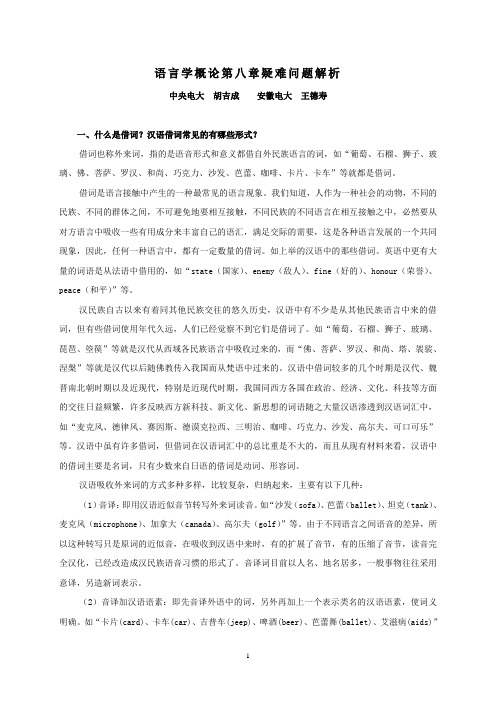
语言学概论第八章疑难问题解析中央电大胡吉成安徽电大王德寿一、什么是借词?汉语借词常见的有哪些形式?借词也称外来词,指的是语音形式和意义都借自外民族语言的词,如“葡萄、石榴、狮子、玻璃、佛、菩萨、罗汉、和尚、巧克力、沙发、芭蕾、咖啡、卡片、卡车”等就都是借词。
借词是语言接触中产生的一种最常见的语言现象。
我们知道,人作为一种社会的动物,不同的民族、不同的群体之间,不可避免地要相互接触,不同民族的不同语言在相互接触之中,必然要从对方语言中吸收一些有用成分来丰富自己的语汇,满足交际的需要,这是各种语言发展的一个共同现象,因此,任何一种语言中,都有一定数量的借词。
如上举的汉语中的那些借词。
英语中更有大量的词语是从法语中借用的,如“state(国家)、enemy(敌人)、fine(好的)、honour(荣誉)、peace(和平)”等。
汉民族自古以来有着同其他民族交往的悠久历史,汉语中有不少是从其他民族语言中来的借词,但有些借词使用年代久远,人们已经觉察不到它们是借词了。
如“葡萄、石榴、狮子、玻璃、琵琶、箜篌”等就是汉代从西域各民族语言中吸收过来的,而“佛、菩萨、罗汉、和尚、塔、袈裟、涅槃”等就是汉代以后随佛教传入我国而从梵语中过来的。
汉语中借词较多的几个时期是汉代、魏晋南北朝时期以及近现代,特别是近现代时期,我国同西方各国在政治、经济、文化、科技等方面的交往日益频繁,许多反映西方新科技、新文化、新思想的词语随之大量汉语渗透到汉语词汇中,如“麦克风、德律风、赛因斯、德谟克拉西、三明治、咖啡、巧克力、沙发、高尔夫、可口可乐”等。
汉语中虽有许多借词,但借词在汉语词汇中的总比重是不大的,而且从现有材料来看,汉语中的借词主要是名词,只有少数来自日语的借词是动词、形容词。
汉语吸收外来词的方式多种多样,比较复杂,归纳起来,主要有以下几种:(1)音译:即用汉语近似音节转写外来词读音。
如“沙发(sofa)、芭蕾(ballet)、坦克(tank)、麦克风(microphone)、加拿大(canada)、高尔夫(golf)”等。
【正式版】语言学概论第八章PPT

一、社会接触与语言接触
❖ 语言接触的类型
1. 不成系统的词汇借用 2. 语言(区域)联盟和系统感染 3. 语言替换和底层残留 4. 通用书面语、民族共同语进入方言或民族语的层次 5. 洋泾浜和混合语
二、不成系统的词汇借用
❖ 借词
1. 借词:即外来词,指语音形式和意义都借自外民族语言的词
化比较发达的民族的经济、政治和文化。
结构简单,语法则是不同语言的混合,且尽可能简化,形态变化
二、不成系统的词汇借用
四、语言的替换和底层
❖ 语言替换的社会原因
1.当两个民族的关系日益密切而逐步发生融合的时候,生产力发展水 平比较低、文化比较落后的民族,学习生产力发展水平比较高、文化 比较发达的民族的经济、政治和文化。政治上是否处于统治地位,并 不是决定的因素。
2.各族人民必须生活在同一地区,形成杂居的局面。
四、语言的替换和底层
❖ 自愿替换和被迫替换 ❖ 自愿替换: ❖ 被替换的语言社会采取积极主动的措施来掌握强势语
言,放弃自己的母语 ❖ ❖ 被迫替换: ❖ 在主观意愿上不愿意放弃自己的母语,但由于强势语
言背后强大的政治、经济或者文化等因素的强大压力而不 得不放弃自己的母语,换用强势语言 ❖ ❖ 我国 上的语言替换: ❖ 隋唐以前,以自愿替换占优势,而在隋唐以后,被迫 替换的比例大一些
巴尔干半岛的语言联盟 我国南部的侗台、苗瑶语族诸语言,藏缅语族的部分语言和境外东南 亚地区属于南亚语系的越南语,属于侗台语族的老挝语、泰语等等, 在语音、语法的结构类型方面十分类似,据研究这也是语言接触造成 的语言联盟
三、语言联盟与系统感染
❖ 系统感染
1. 系统感染 处于同一地区的若干语言在语音、语法系统的结构格局、结构规则
修订版《语言学纲要》第八章语言的接触答案

修订版《语言学纲要》第八章语言的接触答案本页仅作为文档封面,使用时可以删除This document is for reference only-rar21year.March第八章语言的接触一、名词解释借词——借词也叫音义外来词,它指的是音与义都借自外语的词。
如英语中的telephone借子到汉语中是“德律风”,其音义都来自英语。
借词是民族关系的一种见证,是研究民族发展史的一项重要材料。
借词在语言历史的研究中也有非常重要的作用。
语言联盟——语言联盟即“语言的区域分类”。
是指一片地理区域内的不同语言不仅在词汇上相互有大量的借贷,而且在语音、语法系统的结构格局、结构规则方面也十分相似,但各语言仍有相当数量的核心词跟彼此不同。
语言替换——语言换用也称“语言替代”或“语言融合”,是不同民族在长期接触或融合过程中产生的一种语言现象。
指的是一个民族的全体或部分成员放弃使用本民族语言而转用另一民族语言的现象。
语言底层——在语言替换的过程中,换用的强势语言会留下被替换语言的痕迹,这类痕迹通常称为语言底层。
共同语——共同语是社会打破地域隔阂、走向统一时出现的一种语言形式,是在一种方言基础上建立起来的一个民族或一个国家通用的语言。
洋泾浜——“洋泾浜”是当地人在和外来的商人、水手、传教士等打交道的过程中学来的一种变了形的外语。
“洋泾浜”的共同特点是:语音经过当地语言音系的适当改造,语法规则减少到最低限度,词汇的项目比较少,往往要借助于迂回曲折的说法指称事物。
克里奥耳语——混合语是由洋泾浜发展而来的一种有声交际工具,是一种建立在两种或两种以上语言系统基础上形成的并被特定的言语社团作为母语学习使用一种语言。
洋泾浜的特点之一在于它是一定场合下使用的特殊语言,没有人把它当作母语来学习使用。
但是在一定条件下,它也可能被社会采用为主要的交际工具,由孩子们作为母语来学习。
在这种情况下,洋泾浜就变成了混合语,又叫克里奥耳语(Creole,是混血儿的意思)二、填空1、语言发生接触的前提条件是(社会的接触)2、语言接触从根本上说是(使用语言的人之间)接触。
第八章社会语言学
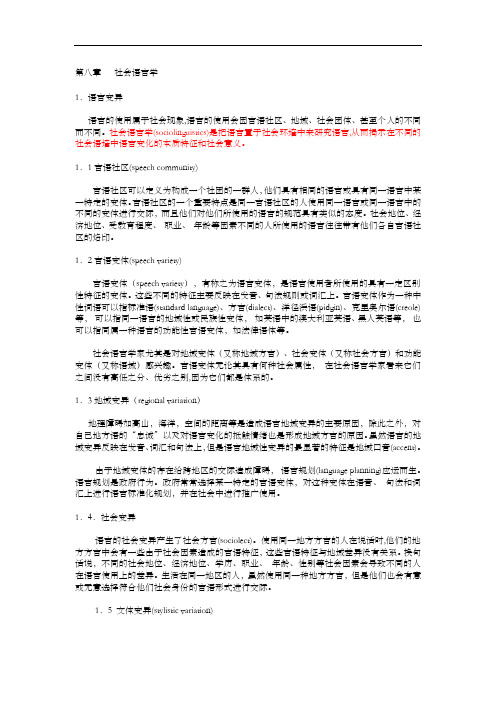
第八章社会语言学1.语言变异语言的使用属于社会现象,语言的使用会因言语社区、地域、社会团体、甚至个人的不同而不同。
社会语言学(sociolinguistics)是把语言置于社会环境中来研究语言,从而揭示在不同的社会语境中语言变化的本质特征和社会意义。
1.1言语社区(speech community)言语社区可以定义为构成一个社团的一群人,他们具有相同的语言或具有同一语言中某一特定的变体。
言语社区的一个重要特点是同一言语社区的人使用同一语言或同一语言中的不同的变体进行交际,而且他们对他们所使用的语言的规范具有类似的态度。
社会地位、经济地位、受教育程度、职业、年龄等因素不同的人所使用的语言往往带有他们各自言语社区的烙印。
1.2言语变体(speech variety)言语变体(speech variety),有称之为语言变体,是语言使用者所使用的具有一定区别性特征的变体。
这些不同的特征主要反映在发音、句法规则或词汇上。
言语变体作为一种中性词语可以指标准语(standard language)、方言(dialect)、洋径浜语(pidgin)、克里奥尔语(creole)等,可以指同一语言的地域性或民族性变体,如英语中的澳大利亚英语、黑人英语等,也可以指同属一种语言的功能性言语变体,如法律语体等。
社会语言学家尤其是对地域变体(又称地域方言)、社会变体(又称社会方言)和功能变体(又称语域)感兴趣。
言语变体无论其具有何种社会属性,在社会语言学家看来它们之间没有高低之分、优劣之别,因为它们都是体系的。
1.3地域变异(regional variation)地理障碍如高山,海洋,空间的距离等是造成语言地域变异的主要原因,除此之外,对自己地方语的“忠诚”以及对语言变化的抵触情绪也是形成地域方言的原因。
虽然语言的地域变异反映在发音、词汇和句法上,但是语言地域性变异的最显著的特征是地域口音(accent)。
由于地域变体的存在给跨地区的交际造成障碍,语言规划(language planning)应运而生。
8语言学概论第八章语言的发展和演变真题习题集锦

语言学概论第八章语言的发展和演变习题、真题集锦一、单选题(本大题共20小题,每小题1分,共20分)1.下面各项中,属于汉语北方方言的是( C )p258A.广州话 B.福州话 C.重庆话 D.上海话2.与北京话同属于一个方言区的是( A )P258A.昆明话B.上海话C.长沙话D.客家话3.与兰州话同属于一个地区的是( A )P258A.长沙话B.昆明话C.厦门话D.梅县话4.与武汉话同属一个方言区的是( B )p258A.长沙话B.成都话C.南昌话D.广州话5.方言之间的差异主要体现在( D )(P258)A.语法方面B.语义方面C.语汇方面D.语音方面6.人们感觉到方言的不同首先是体现在( B )A.语法方面B.语音方面C.语汇方面D.语义方面7.彝族、羌族都来自于( B )P259-260A.古梵语B.原始汉藏语C.古粤语D.古斯拉夫语8.汉语、彝语、苗语、纳西语都来自于( B )p259A.古梵语B.原始汉藏语C.古日耳曼语D.古斯拉夫语9.不同行业有自己的“行话”,“行话”属于( B ) p260A.地域方言 B.社会方言 C.亲属语言 D.混合语言10.一种语言的共同语是在某—个方言的基础上形成的,这种方言叫( C )p262 A.母方言 B.底层方言 C.基础方言 D.原始方言12.吉普、狮子、琵琶”等词都是汉语里的( D )p131/263A.方言词B.常用词C.基本词D.外来词13.下面各词中属于仿译词的是( B )(P263)A.吉普B.热狗C.高尔夫D.尼龙14.用本族语言的语素逐个対译外语原词的语素而产生的词是( B )P263A.音译词B.仿译词C.意译词D.借词16.一个民族的全体或部分成员放弃使用本民族语言转而使用另一民族语言的现象叫( B )p265A.语言混合 B.语言转用 C.克里奥尔 D.双语现象17.语言的替换必然要经历( D )P266A.洋泾滨语阶段B.融合语阶段C.失语阶段D.双语阶段18.语言替换又被视为( B )P265A.语言混用B.语言转用C.语音混合D.语言渗透19.下列关于语言转用的表述,不正确的一项是( C )P265A.语言转用是语言统一的重要形式B.双语现象并非一定导致语言转用C.语言转用以民族融合为必要条件D.语言间的密切接触是语言转用的重要条件20.方言和亲属语言之间具有( A )P259A.语音对应关系B.语汇对应关系C.语义对应关系D.语音对应关系22.亲属语言产生的必要社会条件是(A)P259A.社会的完全地域分化B.社会的不完全地域分化C.社会的完全社群分化D.社会的不完全是社群分化23.语言间亲属关系的重要标志是( D ) P259A.语义对应B.词汇对应关系C.语法对应关系D.语音对应关系24.通常被看作语言亲属关系重要证据的是( B )P259A.语言类型相同 B.语音对应关系 C.地理位置相近 D.语言借用成25.克里奥耳语又叫做( C )P266-268A.皮琴语B.复综语C.混合语D.语言联盟26.洋泾浜语和克里奥耳语属于( C ) P266A.语言的借用B.语言的转用C.语言的混合D.双语现象。
第八章语言的发展

第八章语言的发展名词解释。
1共同语:一个社会的全体成员或大多数人日常生活中使用的语言叫做共同语。
在没有方言分歧的社会里,全体社会成员所使用的语言都是共同语。
2.方言:3.地域方言:地域方言也叫“地区方言”,是全民语言在不同地域的变体,是统一的全民语言的分支。
它是最为常见的语言分化现象。
4.社会方言:由于社会中的人们所处社会地位、职业、年龄、性别、文化高低等方面存在着许多差异,这些差异必然使人们在运用语言方面形成某些个性化或类型化的特点,从而形成了社会方言,各种行业语、阶级方言、黑话等,都属于社会方言。
社会方言也是全民语言的社会变体,是语言分化的结果。
5.亲属语言:凡是从同一种语言分化出来的若干种独立的语言,它们就是亲属语言,亲属语言也是语言分化的结果。
6.标准语:7.克里奥尔语:克里奥尔语是指在各种语言频繁接触的地区出现的一种包含不同语言成分混合自然语言。
8.底层:在语言融合的过程中,胜利的语言也必将从失败的语言中吸收一些成分来丰富自己。
或者说,被同化的语言不会马上彻底消失,还会有一些成分遗留在同化的语言中,这种现象就是底层现象。
复习思考题。
1.谈一谈语言发展的原因和特点。
(1)语言发展的原因:外因:社会的发展是语言发展的基本条件语言是人类最重要的交际工具,它随着社会的产生而产生,随着社会的发展而发展,社会的发展是语言发展的基本条件。
①社会进步推动语言的发展:随着社会生产力的发展,生产关系的改变,以及社会生活的变化,新事物、新概念不断出现,这就要求语言要不断地产生各种各样的词语以适应交际的需要。
②社会的分化和统一推动语言的发展:语言是全社会的交际工具,当社会走向分化的时候,这个社会的各个部分之间交际就会逐渐减少,各个部分成员使用的语言就会产生差异,逐渐形成不同的方言或语言。
另外,由于社会分工的存在,使社会上形成了不同的社会集团,各个集团在语言使用上会形成不同的特点,从而形成社会方言。
反之,如果已经分化的社会各个部分或不同社会之间逐渐走向统一,语言或方言之间的影响加强,促使语言逐渐趋向统一。
英语语言学概论第八章笔记

Chapter 8 Socio-linguistics 社会语言学1.What is socio-linguistics? 什么是社会语言学?Sociolinguistics is the sub-discipline of linguistics that studies language in social contexts.社会语言学是语言学的一个分支,它研究社会环境中的语言。
nguage variation 语言变异a)Speech community 言语社区In sociolinguistic studies, speakers are treated as members of social groups. The social group isolated for any given study is called speech community. A speech community thus defined as a group of people who form a community (which may have as few members as a family or as many member as a country), and share the same language or a particular variety of language. The important characteristic of a speech community is that the members of the group must, in some reasonable way, interact linguistically with other members of the community. They may share closely related language varieties, as well as attitudes toward linguistic norms.社会语言学研究中,说话者被当作是社会群体的成员。
社会语言学 第八章作业
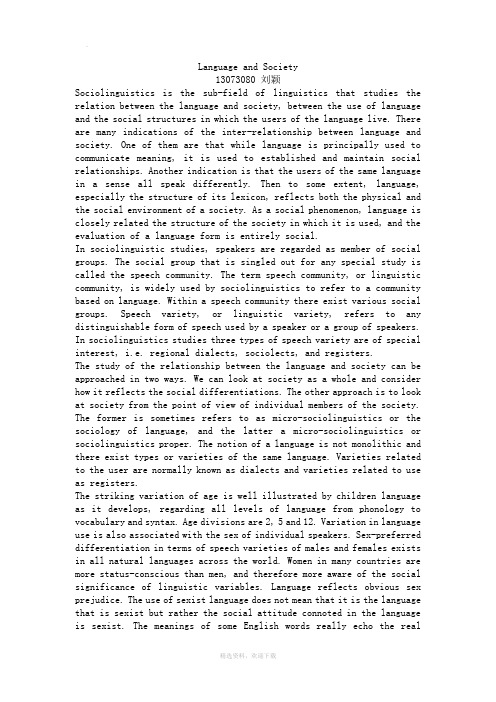
Language and Society13073080 刘颖Sociolinguistics is the sub-field of linguistics that studies the relation between the language and society, between the use of language and the social structures in which the users of the language live. There are many indications of the inter-relationship between language and society. One of them are that while language is principally used to communicate meaning, it is used to established and maintain social relationships. Another indication is that the users of the same language in a sense all speak differently. Then to some extent, language, especially the structure of its lexicon, reflects both the physical and the social environment of a society. As a social phenomenon, language is closely related the structure of the society in which it is used, and the evaluation of a language form is entirely social.In sociolinguistic studies, speakers are regarded as member of social groups. The social group that is singled out for any special study is called the speech community. The term speech community, or linguistic community, is widely used by sociolinguistics to refer to a community based on language. Within a speech community there exist various social groups. Speech variety, or linguistic variety, refers to any distinguishable form of speech used by a speaker or a group of speakers. In sociolinguistics studies three types of speech variety are of special interest, i.e. regional dialects, sociolects, and registers.The study of the relationship between the language and society can be approached in two ways. We can look at society as a whole and consider how it reflects the social differentiations. The other approach is to look at society from the point of view of individual members of the society. The former is sometimes refers to as micro-sociolinguistics or the sociology of language, and the latter a micro-sociolinguistics or sociolinguistics proper. The notion of a language is not monolithic and there exist types or varieties of the same language. Varieties related to the user are normally known as dialects and varieties related to use as registers.The striking variation of age is well illustrated by children language as it develops, regarding all levels of language from phonology to vocabulary and syntax. Age divisions are 2, 5 and 12. Variation in language use is also associated with the sex of individual speakers. Sex-preferred differentiation in terms of speech varieties of males and females exists in all natural languages across the world. Women in many countries are more status-conscious than men, and therefore more aware of the social significance of linguistic variables. Language reflects obvious sex prejudice. The use of sexist language does not mean that it is the language that is sexist but rather the social attitude connoted in the language is sexist. The meanings of some English words really echo the realtraditional roles of men and women in history. As social attitude towards women change in recent years, linguistic changes in many languages are taking place that reflect the feminist movement and the growing awareness that language and language use mirror social attitudes and reinforce stereotypes and bias. The change can be sensed in the morphological variation. Linguistic forms associating sexist prejudice are always intentionally avoided in communication. Gender varieties are caused by society rather than by evolution.Register, in a restricted sense, refers to the variety of language related to one’s occupation. Field of discourse: What is going on: to the area of operation of the language activity. It is concerned with the purpose (why) and subject matter (about what) of communication. It can be either technical or non-technical. Tenor of discourse: the role of relationship in the situation in question: who are the participants in the communication and in what relationship they stand to each other. (Customer-shop-assistant, teacher-student, etc.). Mode of discourse: the means of communication. It is concerned with how communication is carried out. (oral, written, on the line…)Formality refers to the degree of formality in different occasions and reflects the relationship and conversations. According to Martin Joos, there are five stages of formality, namely, intimate, casual, consultative, formal and frozen. The standard variety is a superimposed, socially prestigious dialect of a language. It is the language employed by the government and the judiciary system, used by the mass media, and taught in educational institutions, including school settings where the language is taught as a foreign or second language. The standard language serves as a yard stick against which all other varieties are measured. Features of the standard variety, it is based on a selected variety of the language; usually it is the local speech of an area which is considered the nation’s political and commercial center. It is not a dialect a child acquires naturally like his regional dialect, rather it is taught and learnt in schools. It has some special functions and it the language used on any formal occasions.A pidgin is a special language variety that mixes or blends languages and it is used by people who speak different languages for restricted purposes such as trading. Limited vocabulary and much reduced grammatical structure. When a pidgin has become the primary language of a speech community, and is acquired by the children of that speech community as their native language, it is said to have become a Creole. It is through mistakes and compromises that pidgins develop themselves. A creole is often defined as a pidgin that has become the first language of a new generation of speakers. After a pidgin is creolized, there is another stage of development in which the speakers of the creole may be introduced to the standard language. A post-creole continuum: standard language mayplay the role at one end to fulfill certain social obligation and the creole may function at another end in its specific field. What happens to regional dialect.Diglossia refers to two varieties of a language exist side by side throughout the community, with each having a definite role to play. It is used to describe any stable linguistic situation, in which there exists a strict functional differentiation between a “high” variety and a “low”variety. In some speech communities, two languages are used side by side with each having a different role to play; and language switching occurs when the situation changes. This constitutes the situation of Bilingualism. Diglossia usually describes a situation in which two different varieties of language co-exist in a speech community, each with a distinct range of purely social function and appropriate for certain situations. Diglossia is a not a universal phenomenon. It, for example, hardly exists in English-speaking countries such as Britain and United States. According to Ferguson, diglossia refers to a sociolinguistic situation similar to bilingualism. But instead of two different languages, in a diglossia situation two varieties of a language exist side by side throughout the community, with each having a definite role to play. They estimated that there are more than 6000 languages spoken throughout the world. Multilingualism is mainly created by three reasons: migration, conquest and intermarriage.Welcome !!! 欢迎您的下载,资料仅供参考!。
北语 18秋《社会语言学》
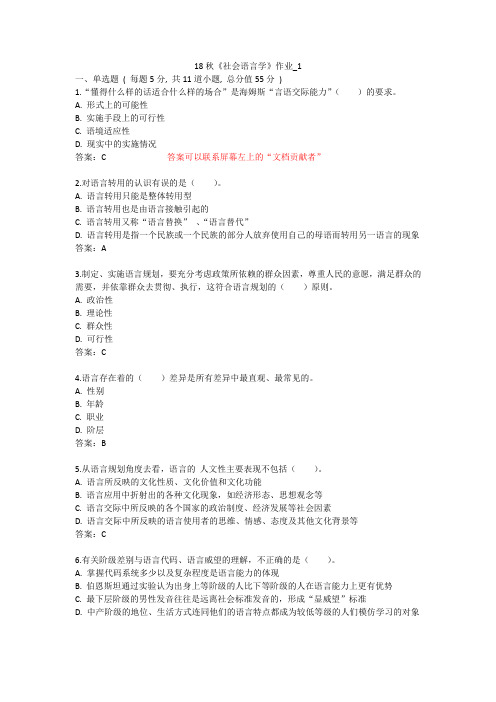
18秋《社会语言学》作业_1一、单选题( 每题5分, 共11道小题, 总分值55分)1.“懂得什么样的话适合什么样的场合”是海姆斯“言语交际能力”()的要求。
A. 形式上的可能性B. 实施手段上的可行性C. 语境适应性D. 现实中的实施情况答案:C 答案可以联系屏幕左上的“文档贡献者”2.对语言转用的认识有误的是()。
A. 语言转用只能是整体转用型B. 语言转用也是由语言接触引起的C. 语言转用又称“语言替换”、“语言替代”D. 语言转用是指一个民族或一个民族的部分人放弃使用自己的母语而转用另一语言的现象答案:A3.制定、实施语言规划,要充分考虑政策所依赖的群众因素,尊重人民的意愿,满足群众的需要,并依靠群众去贯彻、执行,这符合语言规划的()原则。
A. 政治性B. 理论性C. 群众性D. 可行性答案:C4.语言存在着的()差异是所有差异中最直观、最常见的。
A. 性别B. 年龄C. 职业D. 阶层答案:B5.从语言规划角度去看,语言的人文性主要表现不包括()。
A. 语言所反映的文化性质、文化价值和文化功能B. 语言应用中折射出的各种文化现象,如经济形态、思想观念等C. 语言交际中所反映的各个国家的政治制度、经济发展等社会因素D. 语言交际中所反映的语言使用者的思维、情感、态度及其他文化背景等答案:C6.有关阶级差别与语言代码、语言威望的理解,不正确的是()。
A. 掌握代码系统多少以及复杂程度是语言能力的体现B. 伯恩斯坦通过实验认为出身上等阶级的人比下等阶级的人在语言能力上更有优势C. 最下层阶级的男性发音往往是远离社会标准发音的,形成“显威望”标准D. 中产阶级的地位、生活方式连同他们的语言特点都成为较低等级的人们模仿学习的对象7.对以社会交际为导向的教学标准的认识有误的是()。
A. Munby的大纲,开启了以交际功能为导向的第二语言教学路径B. 产生了交际法、任务型教学等教学模式C. 《交际大纲设计》使言语交际微观交际功能项目体系得到完善D. 中国也编制了一些用于对外汉语教学的交际功能的大纲8.同语言变异有关的社会变量多种多样,()是诸多变量中最重要的参数。
社会语言学 第八章作业
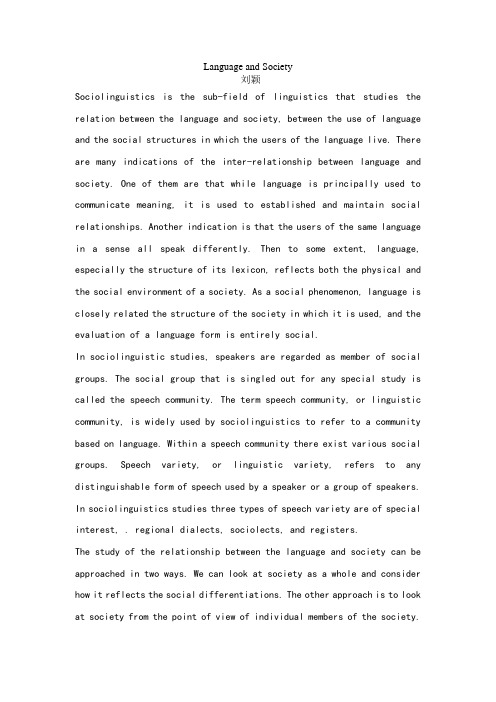
Language and Society刘颖Sociolinguistics is the sub-field of linguistics that studies the relation between the language and society, between the use of language and the social structures in which the users of the language live. There are many indications of the inter-relationship between language and society. One of them are that while language is principally used to communicate meaning, it is used to established and maintain social relationships. Another indication is that the users of the same language in a sense all speak differently. Then to some extent, language, especially the structure of its lexicon, reflects both the physical and the social environment of a society. As a social phenomenon, language is closely related the structure of the society in which it is used, and the evaluation of a language form is entirely social.In sociolinguistic studies, speakers are regarded as member of social groups. The social group that is singled out for any special study is called the speech community. The term speech community, or linguistic community, is widely used by sociolinguistics to refer to a community based on language. Within a speech community there exist various social groups. Speech variety, or linguistic variety, refers to any distinguishable form of speech used by a speaker or a group of speakers. In sociolinguistics studies three types of speech variety are of special interest, . regional dialects, sociolects, and registers.The study of the relationship between the language and society can be approached in two ways. We can look at society as a whole and consider how it reflects the social differentiations. The other approach is to look at society from the point of view of individual members of the society.The former is sometimes refers to as micro-sociolinguistics or the sociology of language, and the latter a micro-sociolinguistics or sociolinguistics proper. The notion of a language is not monolithic and there exist types or varieties of the same language. Varieties related to the user are normally known as dialects and varieties related to use as registers.The striking variation of age is well illustrated by children language as it develops, regarding all levels of language from phonology to vocabulary and syntax. Age divisions are 2, 5 and 12. Variation in language use is also associated with the sex of individual speakers. Sex-preferred differentiation in terms of speech varieties of males and females exists in all natural languages across the world. Women in many countries are more status-conscious than men, and therefore more aware of the social significance of linguistic variables. Language reflects obvious sex prejudice. The use of sexist language does not mean that it is the language that is sexist but rather the social attitude connoted in the language is sexist. The meanings of some English words really echo the real traditional roles of men and women in history. As social attitude towards women change in recent years, linguistic changes in many languages are taking place that reflect the feminist movement and the growing awareness that language and language use mirror social attitudes and reinforce stereotypes and bias. The change can be sensed in the morphological variation. Linguistic forms associating sexist prejudice are always intentionally avoided in communication. Gender varieties are caused by society rather than by evolution.Register, in a restricted sense, refers to the variety of language related to one’s occupation. Field of discourse: What is going on: to the areaof operation of the language activity. It is concerned with the purpose (why) and subject matter (about what) of communication. It can be either technical or non-technical. Tenor of discourse: the role of relationship in the situation in question: who are the participants in the communication and in what relationship they stand to each other. (Customer-shop-assistant, teacher-student, etc.). Mode of discourse: the means of communication. It is concerned with how communication is carried out. (oral, written, on the li ne…)Formality refers to the degree of formality in different occasions and reflects the relationship and conversations. According to Martin Joos, there are five stages of formality, namely, intimate, casual, consultative, formal and frozen. The standard variety is a superimposed, socially prestigious dialect of a language. It is the language employed by the government and the judiciary system, used by the mass media, and taught in educational institutions, including school settings where the language is taught as a foreign or second language. The standard language serves as a yard stick against which all other varieties are measured. Features of the standard variety, it is based on a selected variety of the language; usually it is the local speech of an area which is considered the nation’s political and commercial center. It is not a dialect a child acquires naturally like his regional dialect, rather it is taught and learnt in schools. It has some special functions and it the language used on any formal occasions.A pidgin is a special language variety that mixes or blends languages and it is used by people who speak different languages for restricted purposes such as trading. Limited vocabulary and much reduced grammatical structure. When a pidgin has become the primary language of a speechcommunity, and is acquired by the children of that speech community as their native language, it is said to have become a Creole. It is through mistakes and compromises that pidgins develop themselves. A creole is often defined as a pidgin that has become the first language of a new generation of speakers. After a pidgin is creolized, there is another stage of development in which the speakers of the creole may be introduced to the standard language. A post-creole continuum: standard language may play the role at one end to fulfill certain social obligation and the creole may function at another end in its specific field. What happens to regional dialect.Diglossia refers to two varieties of a language exist side by side throughout the community, with each having a definite role to play. It is used to describe any stable linguistic situation, in which there exists a strict functional differentiation between a “high” variety and a “low” variety. In some speech communities, t wo languages are used side by side with each having a different role to play; and language switching occurs when the situation changes. This constitutes the situation of Bilingualism. Diglossia usually describes a situation in which two different varieties of language co-exist in a speech community, each with a distinct range of purely social function and appropriate for certain situations. Diglossia is a not a universal phenomenon. It, for example, hardly exists in English-speaking countries such as Britain and United States. According to Ferguson, diglossia refers to a sociolinguistic situation similar to bilingualism. But instead of two different languages, in a diglossia situation two varieties of a language exist side by side throughout the community, with each having a definite role to play. They estimated that there are more than 6000 languages spoken throughout theworld. Multilingualism is mainly created by three reasons: migration, conquest and intermarriage.。
现代语言学第八章 社会语言学
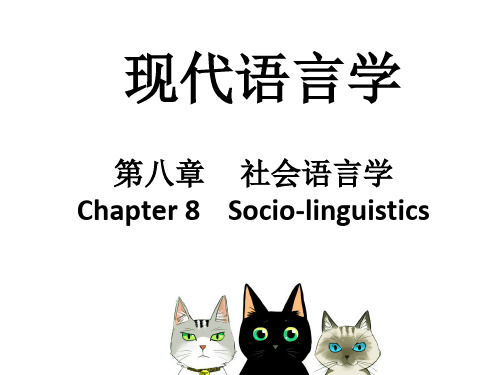
意或无意选择符合他们社会身 dialect社会方言
• 社会方言(social dialect 或sociolect)指社会中属 于同一阶级、阶层、或社会群体所使用的语言 变体。社会方言通行于有着相同社会背景的群 体之中。社会群体的多样化决定了社会方言的 多样化。 Social dialects, or sociolects, are varieties of language used by people belonging to particular social classes. The speakers of a social dialect usually share a similar social background.
现代语言学
第八章 社会语言学 Chapter 8 Socio-linguistics
What is socio-linguistics? 什么是社会语言学?
• Sociolinguistics is the sub-discipline亚学科 of linguistics that studies language in social contexts. • 社会语言学(sociolinguistics)是一门语言学的分支 学科,把语言置于社会环境中来研究语言。 • 社会是怎样给人分组的?Social group(贴标签)
受过相同教育的人往往使用相同的被称之为教 育变体的社会方言。例如,具有高等学历的学 生与早期辍学的学生相比,他们的语言形式更 加书面化。
•
年龄变体
• The way language is used correlates with一一对应 the age of individual speakers. The importance of age as a social factor in language variation is strikingly demonstrated显著 的呈现 by children’s language as it develops with age. While some differences in pronunciation发音 are found to correlate with different generation of speakers, the most striking differences are lexical词汇的.
(完整)《语言学纲要》指导书习题答案(7-9章)

第七章语言随着社会的发展而发展一、解释下列名词(20分,每词4分)1、方言:是语言的变体,是因为地域或社会的原因而发生的语言分化。
2、社会方言:指社会内部因年龄、性别、职业、阶级、阶层的人们在使用语言上表现出来的变异,是言语社团的一种标志。
3、地域方言:是一种语言在不同地域上的分支,语言的地方变体。
4、共同语:是在某个方言的基础上形成的一个民族的通用语言。
5、亲属语言:是从同一种语言分化出来的,彼此有同源关系的几种独立的语言。
二、填空题(30分,每空4分)1、社会的发展是语言发展的基本条件。
2、渐变性和不平衡性是语言发展的两大特点。
3、语言的发展中,词汇的变化速度最快,语音次之,而语法的演变最为缓慢。
4、语言发展的两个基本过程是语言的分化和语言的统一.5、社会方言是因社会的分工而出现的语言分化,行业用语、科学技术术语、阶级方言都是常见的社会方言.6、黑话是一种特殊的社会方言,它具有强烈的排他性。
7、地域方言的差别,主要表现在语音上,划分地域方言的主要依据也是语音。
8、地域方言的进一步分化就会发展为独立的语言、这些源自一个共同语分化的语言归属于同一个亲属语言,这个成为不同语言发展源头的共同语称为母语。
9、汉藏语系和印欧语系是世界上使用人数最多的两个语系。
10、按谱系分类,英语属于印欧语系日耳曼语族。
11、共同语是在一种语言或方言的基础上形成的。
12、在一个多民族的国家中,各民族之间往往还需要一个共同的交际工具,这就是所谓的国语,我国的普通话就是这样的一种共同语.13、语言规范化的对象主要是书面语。
14、约定俗成的原则在规范化的工作中有重要作用,它本身就是规范化的一个原则和标准.15、一种方言能成为共同语的基础方言,主要取决于客观的政治、经济、文化等各方面的条件。
16、汉语的普通话,根据规范化的要求,确定为以北京语音为标准音,以北方话为基础方言,以典范的现代白话文著作为语法规范。
三、辨别正误(20分,每小题2分)1、语言的发展都具有渐变性。
北语 18春《社会语言学》

18春《社会语言学》作业_1一、单选题( 每题4分, 共10道小题, 总分值40分)1.语言规划的政策性原则,不包括()。
A. 政治性B. 系统性C. 群众性D. 理论性答案:B2.“双重语言现象”和“双层语言现象”在一个社会里稳定并存,是社会语言竞争、发展的结果。
这一观点是由()提出来的。
A. Charles FergusonB. FishmanC. SaussureD. Francis答案:B3.社会语言学研究中的个人因素不包括()。
A. 年龄B. 性别C. 受教育程度D. 语境答案:D4.严格意义上的社会语言学研究在中国应该开始于()。
A. 20世纪60年代B. 20世纪70年代C. 20世纪80年代D. 20世纪90年代答案:C5.亲属称谓有不同的亚系统,其中比较重要的是面称、()亚系统。
A. 他称B. 自称C. 旁称D. 对称答案:C6.在现代汉语中,最常用的词是以()占绝大多数。
A. 单音节B. 双音节C. 三音节D. 多音节7.1959年新加坡成为马来西亚的一个自治邦,()在名义上被当作国语,但实际上,可以说是徒有虚名。
A. 华语B. 马来语C. 英语D. 泰米尔语8.香港和()之间的新词接近率是最高的,因为两地的方言相同,都使用粤语,并且交流也频繁。
A. 上海B. 北京C. 澳门D. 台湾9.近年来产生的()为社会语言学带来崭新的研究工具。
A. 语料库语言学B. 实验语言学C. 认知语言学D. 结构语言学10.国内和海外各地华语文在词语上存在不少差异,主要是由于受外来文化影响衍生的()不同。
A. 新语音B. 新词C. 新语法D. 新句子二、多选题( 每题4分, 共5道小题, 总分值20分)1.下列属于社会语言学研究方法的是()。
A. 多人次抽样调查B. 定量分析C. 快速隐秘调查法D. 配对变法答案:ABCD2.下列说法正确的是哪项?A. 语言学的社会语言学的研究目标纯粹是为了充实和完善语言B. 民族学的社会语言学研究的最终目标是要建立综合性的人类交际科学C. 社会学的社会语言学的主要任务是解决社会所面临的重大语言问题D. 态度研究不属于社会语言学的范畴3.下列关于语言中性别差异的起因的说法正确的是哪些项?A. 女性对言语这一标志的重要性不够敏感B. 女性的社会地位决定的C. 女性的心理状态决定的D. 女性的社会角色和活动天地决定的4.社会语言学界在分析语言的阶级、阶层变异时,目前中国内地的社会分层为()。
刘润清《新编语言学教程》章节题库-第八章至第十二章【圣才出品】
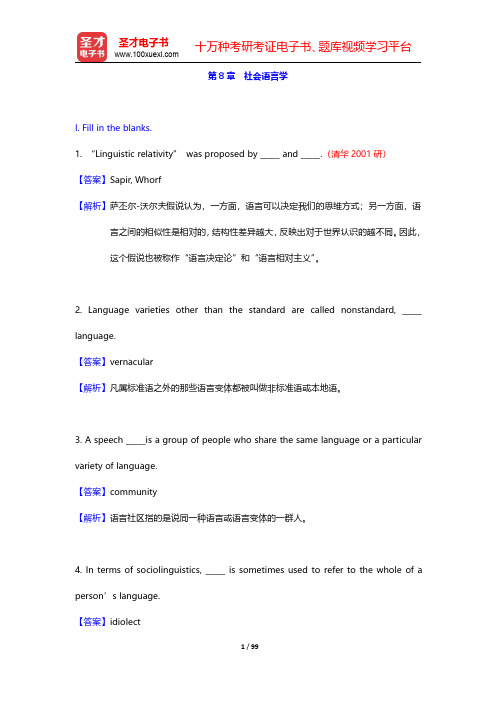
第8章社会语言学I.Fill in the blanks.1.“Linguistic relativity”was proposed by_____and_____.(清华2001研)【答案】Sapir,Whorf【解析】萨丕尔-沃尔夫假说认为,一方面,语言可以决定我们的思维方式;另一方面,语言之间的相似性是相对的,结构性差异越大,反映出对于世界认识的越不同。
因此,这个假说也被称作“语言决定论”和“语言相对主义”。
nguage varieties other than the standard are called nonstandard,_____ language.【答案】vernacular【解析】凡属标准语之外的那些语言变体都被叫做非标准语或本地语。
3.A speech_____is a group of people who share the same language or a particular variety of language.【答案】community【解析】语言社区指的是说同一种语言或语言变体的一群人。
4.In terms of sociolinguistics,_____is sometimes used to refer to the whole of a person’s language.【答案】idiolect【解析】从社会语言学的角度讲,个人习语指个人语言风格。
5.In many societies of the world,we find a large number of people who speak more than one language.As a characteristic of societies,_____inevitably results from the coming into contact of people with different cultures and different languages.【答案】bilingualism【解析】双语现象源于不同文化和不同语言相互交流的结果。
语言学纲要思考题(第7、8、9章
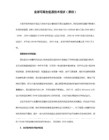
语言的统一有哪些情况?
语言是随着社会的统一而统一的。随着社会的发展,原来一个地方割据的,不很统一的社会可以完全统一起来;原来几个独立的社会也可以统一为一个社会。这时候,原来的地域方言或语言间的分歧就会妨碍人们在全社会范围内进行交际,这种状况不利于社会的完全统一和统一的巩固,于是语言也会适应社会统一的要求而逐步向减少分歧、趋向一致的统一方向发展。
地域方言:在地域上会形成社会的不完全的分化,一个地区中出现的语言新成分一般不大容易传播到其他地区去;这个地区内语言中某些固有成分的改变或消失一般也不大容易波及其他地区。因此共同语就在各个地区形成了变体,即地域方言。
方言形成以后,如果社会仍然处于不充分统一(或分化)的状态中,方言就一方面保持自己的特点,一方面又服从自己所从属的语言的发展趋势,继续作为该语言的方言。如果社会完全分裂成几个各自独立的社会,那么各方言就可能失去约束,不断扩大自己的特点,并进一步发展成独立的语言,这些从同一种语言分化出来的各个语言,叫做亲属语言。
由此可见,语言作为社会现象和交际工具是随着社会的发展变化而不断发展变化的,社会的发展是语言发展变化的原动力。
如何理解语言系统内部各要素的相互影响是语言发展的内部因素?
语言作为由语音、词汇、语法三要素构成的一个符号系统,其内部各种要素处于一种对立统一的关系之中,各自既具有相对独立性,又是一个统一的整体,相互间呈现一种平衡的状态,如果某一因素发生了变化,就破坏了原有的平衡,其它因素也要相应地变化以达到新的平衡,这样就引起了语言的变化。
语言的分化过程是什么?
语言的分化过程是指各方言之间、各亲属语言之间差别扩大,语言增多的过程。
语言分化为不同方言是社会分化的伴随现象。社会的发展造成社会内进一步的分工或社团居民在地域上的向外扩展,这样单一社会就分化为若干个社团,社团内成员的交际比较密切,不同社团的成员交际较稀疏。这样,在某一个社团内出现的语言变化往往能在本社团内很快推开而不能同样快地扩展到其他社团,从而形成不同社会方言或地域方言的差异。
北语11秋《社会语言学》作业1、2、3、4
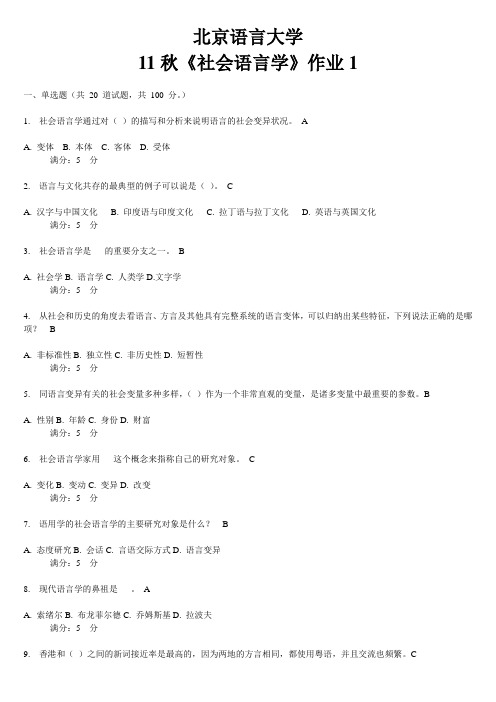
北京语言大学11秋《社会语言学》作业1一、单选题(共20 道试题,共100 分。
)1. 社会语言学通过对()的描写和分析来说明语言的社会变异状况。
AA. 变体B. 本体C. 客体D. 受体满分:5 分2. 语言与文化共存的最典型的例子可以说是()。
CA. 汉字与中国文化B. 印度语与印度文化C. 拉丁语与拉丁文化D. 英语与英国文化满分:5 分3. 社会语言学是___的重要分支之一。
BA. 社会学B. 语言学C. 人类学D.文字学满分:5 分4. 从社会和历史的角度去看语言、方言及其他具有完整系统的语言变体,可以归纳出某些特征,下列说法正确的是哪项? BA. 非标准性B. 独立性C. 非历史性D. 短暂性满分:5 分5. 同语言变异有关的社会变量多种多样,()作为一个非常直观的变量,是诸多变量中最重要的参数。
BA. 性别B. 年龄C. 身份D. 财富满分:5 分6. 社会语言学家用___这个概念来指称自己的研究对象。
CA. 变化B. 变动C. 变异D. 改变满分:5 分7. 语用学的社会语言学的主要研究对象是什么? BA. 态度研究B. 会话C. 言语交际方式D. 语言变异满分:5 分8. 现代语言学的鼻祖是___。
AA. 索绪尔B. 布龙菲尔德C. 乔姆斯基D. 拉波夫满分:5 分A. 上海B. 北京C. 澳门D. 台湾满分:5 分10. 语音的性别差异主要表现在___上。
DA. 音高B. 音强C. 音量D. 音质满分:5 分11. 中国社会语言学的开创之作是罗常培先生的___。
AA. 语言与文化B. 语言学概论C. 社会语言学概论D. 社会语言学导论满分:5 分12. 语体根据交际方式的不同可以分为口头语体和()。
BA. 正式语体B. 书面语体C. 文字语体D. 非正式语体满分:5 分13. 语言与阶级的()关系问题,是社会语言学的一个广泛而长期的研究领域。
CA. 共振B. 共生C. 共变D. 共存满分:5 分14. 关于语言变体、言语共同体、交际能力三个概念,下列说法正确的是哪项?BA. 语言变体是划分语言使用者的基本单位B. 三个概念是社会语言学的基本概念C. 言语共同体是研究基础理论主要突破口D. 交际能力是分析语言现象的基本单位满分:5 分15. 社会语言学家普遍认同的观点是()。
第八章---中介语

虽然“中介语”这个词不是由Corder所提出, 然而他对于中介语研究的开创是具有重大贡 献的。其理论主张主要有以下几点:
9
• (一)“过渡能力”和“过渡方言”
• Corder (1967,1971)将学习者的语言系 统称作“过渡能力”(transitional competence)系统或“过渡方 言”(transitional dialect)。所谓“过渡
上的,它忽略了学习者作为语言学习的主体这
一基本事实,同时也忽略了学习者的学习过程。
在这种情况下,人们开始把眼光投向学习者本
身,因而大家在放弃对比分析“强势说”的同
时,越来越倾向其“弱势说”。“弱势说”的
解释性使其演变为偏误分析的一部分。
3
• 1967年,Corder发表了《学习者偏误的意义》 的文章,将人们的注意力引到学习者的身上。 Corder在文章中试图改变人们对于学习者偏 误的负面的看法,即认为偏误作为学习障碍 需要彻底根除。 Corder认为,人们可以从学 习者的偏误入手观察学习者所具有的语言系 统,而偏误实际上反映了学习者主体在学习 过程中对目的语体系的一种判断和推测。虽 然对比分析的“弱势说”强调解释,而其解 释还是从母语和目的语两种语言系统的对比 中来,而偏误分析则在此基础上主要将学习 者的语言系统和目的语语言系统进行对比, 从心理语言学、社会语言学、篇章分析等角 度出发在更广阔的范围内解释学习者产生偏 误的原因,而不仅仅局限于从母语和目的语 两种语言系统的差异中寻找解释。
新编简明英语语言学-Chapter-8-Language-and-society
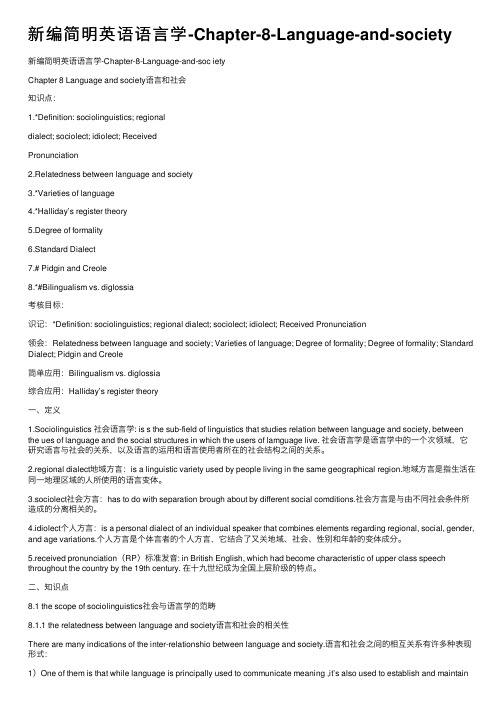
新编简明英语语⾔学-Chapter-8-Language-and-society新编简明英语语⾔学-Chapter-8-Language-and-soc ietyChapter 8 Language and society语⾔和社会知识点:1.*Definition: sociolinguistics; regionaldialect; sociolect; idiolect; ReceivedPronunciation2.Relatedness between language and society3.*Varieties of language4.*Halliday’s register theory5.Degree of formality6.Standard Dialect7.# Pidgin and Creole8.*#Bilingualism vs. diglossia考核⽬标:识记:*Definition: sociolinguistics; regional dialect; sociolect; idiolect; Received Pronunciation领会:Relatedness between language and society; Varieties of language; Degree of formality; Degree of formality; Standard Dialect; Pidgin and Creole简单应⽤:Bilingualism vs. diglossia综合应⽤:Halliday’s register theory⼀、定义1.Sociolinguistics 社会语⾔学: is s the sub-field of linguistics that studies relation between language and society, between the ues of language and the social structures in which the users of lamguage live. 社会语⾔学是语⾔学中的⼀个次领域,它研究语⾔与社会的关系,以及语⾔的运⽤和语⾔使⽤者所在的社会结构之间的关系。
- 1、下载文档前请自行甄别文档内容的完整性,平台不提供额外的编辑、内容补充、找答案等附加服务。
- 2、"仅部分预览"的文档,不可在线预览部分如存在完整性等问题,可反馈申请退款(可完整预览的文档不适用该条件!)。
- 3、如文档侵犯您的权益,请联系客服反馈,我们会尽快为您处理(人工客服工作时间:9:00-18:30)。
Language and Society13073080 刘颖Sociolinguistics is the sub-field of linguistics that studies the relation between the language and society, between the use of language and the social structures in which the users of the language live.There are many indications of the inter-relationship between language and society. One of them are that while language is principally used to communicate meaning, it is used to established and maintain social relationships. Another indication is that the users of the same language in a sense all speak differently. Then to some extent, language, especially the structure of its lexicon, reflects both the physical and the social environment of a society. As a social phenomenon, language is closely related the structure of the society in which it is used, and the evaluation of a language form is entirely social.In sociolinguistic studies, speakers are regarded as member of social groups. The social group that is singled out for any special study is called the speech community. The term speech community, or linguistic community, is widely used by sociolinguistics to refer to a community based on language. Within a speech community there exist various social groups. Speechvariety, or linguistic variety, refers to any distinguishable form of speech used by a speaker or a group of speakers. In sociolinguistics studies three types of speech variety are of special interest, i.e. regional dialects, sociolects, and registers.The study of the relationship between the language and society can be approached in two ways. We can look at society as a whole and consider how it reflects the social differentiations. The other approach is to look at society from the point of view of individual members of the society. The former is sometimes refers to as micro-sociolinguistics or the sociology of language, and the latter a micro-sociolinguistics or sociolinguistics proper. The notion of a language is not monolithic and there exist types or varieties of the same language. Varieties related to the user are normally known as dialects and varieties related to use as registers.The striking variation of age is well illustrated by children language as it develops, regarding all levels of language from phonology to vocabulary and syntax. Age divisions are 2, 5 and 12. Variation in language use is also associated with the sex of individual speakers. Sex-preferred differentiation in terms of speech varieties of males and females exists in all natural languages across the world. Women in many countries are more status-conscious than men, and therefore more aware of the social significance of linguistic variables. Language reflects obvious sex prejudice. The use of sexist language does not mean that it is the language that is sexist but rather the social attitude connoted in the language is sexist. The meanings of some English words really echo the real traditional roles of men and women in history. As social attitude towards women change in recent years, linguistic changes in many languages are taking place that reflect the feminist movement and the growing awareness that language and language use mirror social attitudes and reinforce stereotypes and bias. The change can be sensed in the morphological variation. Linguistic forms associating sexist prejudice are always intentionally avoided in communication. Gender varieties are caused by society rather than by evolution.Register, in a restricted sense, refers to the variety of language related to one’s occupation. Field of discourse: What is going on: to the area of operation of the language activity. It is concerned with the purpose (why) and subject matter (about what) of communication. It can be either technical or non-technical. Tenor of discourse: the role of relationship in the situation in question: who are the participants in the communication and in what relationship they stand to each other. (Customer-shop-assistant, teacher-student, etc.). Mode of discourse: the means of communication. It is concerned with how communication is carried out. (oral, written, on the line…)Formality refers to the degree of formality in different occasions and reflects the relationship and conversations. According to Martin Joos, there are five stages of formality, namely, intimate, casual, consultative, formal and frozen. The standard variety is a superimposed, socially prestigious dialect of a language. It is the language employed by the government and the judiciary system, used by the mass media, and taught in educational institutions, including school settings where the language is taught as a foreign or second language. The standard language serves as a yard stick against which all other varieties are measured. Features of the standard variety, it is based on a selected variety of the language; usually it is the local speech of an area which is considered the nation’s political and commercial center. It is not a dialect a child acquires naturally like his regional dialect, rather it is taught and learnt in schools. It has some special functions and it the language used on any formal occasions.A pidgin is a special language variety that mixes or blends languages and it is used by people who speak different languages for restricted purposes such as trading. Limited vocabulary and much reduced grammatical structure. When a pidgin has become the primary language of a speech community, and is acquired by the children of that speech community as their native language, it is said to have become a Creole. It is through mistakes and compromises that pidgins develop themselves. A creole is often defined as a pidgin that has become the first language of a new generation of speakers. After a pidgin is creolized, there is another stage of development in which the speakers of the creole may be introduced to the standard language. A post-creole continuum: standard language may play the role at one end to fulfill certain social obligation and the creole may function at another end in its specific field. What happens to regional dialect.Diglossia refers to two varieties of a language exist side by side throughout the community, with each having a definite role to play. It is used to describe any stable linguistic situation, in which there exists a strict functional differentiation between a “high” variety and a “low” variety. In some speech communities, two languages are used side by side with each having a different role to play; and language switching occurs when the situation changes. This constitutes the situation of Bilingualism. Diglossia usually describes a situation in which two different varieties of language co-exist in a speech community, each with a distinct range of purely social function and appropriate for certain situations. Diglossia is a not a universal phenomenon. It, for example, hardly exists in English-speaking countries such as Britain and UnitedStates. According to Ferguson, diglossia refers to a sociolinguistic situation similar to bilingualism. But instead of two different languages, in a diglossia situation two varieties of a language exist side by side throughout the community, with each having a definite role to play. They estimated that there are more than 6000 languages spoken throughout the world. Multilingualism is mainly created by three reasons: migration, conquest and intermarriage.。
